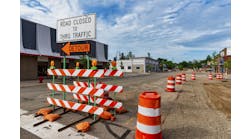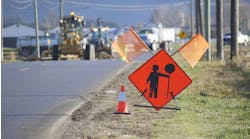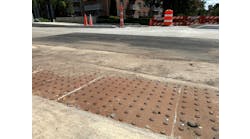In his 1955 State of the Union address, President Dwight D. Eisenhower advocated the importance of a national highway system to better our growing country. Ike proclaimed to Congress that “a modern, efficient highway system is essential to meet the needs of our growing population, our expanding economy and our national security.” Just over a year later, Eisenhower’s dream became a reality as he signed the Federal Aid Highway Act and the first miles of interstate highway were laid in Missouri.
Fast-forward 51 years to today and this very system that has helped to grow our country and its economy is now becoming the nemesis of trade within our own borders. With a surface transportation system already at capacity—far surpassing traffic volumes that were anticipated when it was first constructed—the U.S. loses $8 billion and 243 million hours a year to highway freight bottlenecks. And it’s only going to get worse.
With U.S. total trade rapidly growing, along with population totals, freight traffic is expected to increase 100% over the next 20 years. And while the trucking industry carries 69% of the freight that moves through the U.S., the question is: How will we move this commerce in the future?
Moving more and more
Since the early Colonials first settled in what would become America, the economy has been built upon and depended on transportation. The 18th century depended on water transport and coastal trade. The 19th century saw the rise of rail technology as east-west routes were built to follow the westward expansion of the country.
With the development of the automobile and a highway system that linked regional economies from all directions, trucks became the mode of transporting U.S. commerce during the 20th century. By connecting all regions of the country by road, Pacific and Gulf trade expanded through the ports. The U.S. has stepped into the 21st century with a leading global economy. However, challenges on the home front face our nation’s financial system.
“Last fall, the U.S. Department of Transportation and Federal Highway Administration [FHWA] released a report that there are 233 highway truck bottlenecks,” David Bauer, senior vice president for government relations, American Road & Transportation Builders Association (ARTBA), told Roads & Bridges. “Bottlenecks by their nature are not necessarily the problem. They’re the symptom of the problem. Bottlenecks are what happens when you have a system-wide capacity shortage.”
We live in a world today that strives to be faster than it was yesterday. Next-day deliveries, same-day deliveries and just-in-time deliveries dominate our economy. But what many people do not realize is that every time they order books from Amazon .com or unusual memorabilia from eBay, and expect these items in two to three business days or less, there will be that many more trucks congesting our roadways as they attempt to deliver the goods in time.
“We’re so focused on how advanced our economy has become and how you can use technology for a great many things,” Bauer said, “but the bottom line is you’ve still got to get it there.”
Commerce congestion
While the U.S. economy and trade have been rapidly growing, in the last 20 years the U.S. has only added about 6% to the nation’s highway capacity. At the same time, the amount of vehicle-miles traveled and the number of vehicles on the road have doubled and the population has grown significantly. As a result, the U.S. is becoming a nation bound by gridlock.
“There are two issues we face with congestion,” Darrin Roth, director of highway operations, American Trucking Associations (ATA), told Roads & Bridges. “One is when you’re sitting in congestion, you’re burning more fuel. Your drivers and vehicles are being less productive, so that by itself increases the cost of moving freight.”
The second impact, according to Roth, is the loss of reliability. With the advent of just-in-time deliveries, businesses have reduced inventories on hand and rely on shipments from trucks to replenish their stock within a certain time frame. If a shipment is unable to arrive on time, the business will be short on inventory.
“Congestion is a major problem because of the additional costs and the impact on the ability of shippers to efficiently manage their supply chains,” said Roth.
As congestion continues to worsen, U.S. businesses will suffer. “Transportation costs themselves will increase, and they have been increasing,” Roth said. The increased cost of fuel and loss of productivity within the trucking industry have contributed to the increase, according to Roth. “Businesses will also have to start building inventory—holding on to more inventory to account for a less reliable delivery system,” he said, “and holding inventory can be extremely expensive.”
What these additional costs will ultimately do is reduce U.S. business’ global competitiveness.
The global problem
According to government predictions, the U.S. is expected to have 47,000 miles of interstate highways by the year 2020, adding only 1,130 miles between the years 2000 and 2020. At the same time, Europe is expected to grow its highway system to over 55,490 miles, and India currently is constructing a national highway system that will have more than 25,000 miles by the year 2020.
China also is constructing an interstate highway system that is designed to move commerce and will add more than 42,000 miles of highway in the next 15 years. By 2020, China is expected have more than 52,000 miles of highway.
While other nations are taking steps to upgrade surface transportation infrastructure to deal with economic challenges, the U.S. is adding only 6% to its highway system, said Bauer, and the last federal highway bill only kept pace with inflation. “I think that either we are going to be passed,” Bauer said, “or we are going to figure out a way to start stepping up to the plate and trying to ensure that our transportation infrastructure network allows us to compete on the global marketplace.”
So just how will the U.S. compete globally?
“It’s going to require more investment in some capacity,” said Bauer. “I think that state, federal and local governments all have to be involved.”
The ATA agrees that more funding is necessary to avoid an economic disaster because of congestion. “We think that, starting with Congress, states and local governments have a major role to play,” said Roth. “We believe that Congress needs to focus its resources on highway projects that are of critical national and regional importance.”
And while the federal gasoline tax has not been increased since 1993, it would not be unrealistic for Congress to go ahead and raise that contribution. “It’s entirely unrealistic for elected officials and the American people to believe they can contribute the same amount to upgrading the nation’s surface transportation system today as they did 14 years ago and to get anything near a similar type of deliverable,” Bauer said.
Public-private partnerships also will help funding situations in the future. “Public-private partnerships can and must be utilized where they make sense,” said Bauer, “but people should be under no false impression that this is the only thing that is going to be necessary.”
Passing through Virginia
The lack of funding is a problem with current I-81 improvements in Virginia. The 325-mile-long interstate includes 90 interchanges and is one of the top eight trucking routes in the U.S., serving as a main link between southern economic hubs and northeast markets. I-81 was originally designed to carry 15% truck traffic. However, recent data shows the roadway to carry an average of 26% trucks.
The possible expansion of this roadway had been long discussed, but because I-81 is federally funded, changes to the highway must comply with federal laws. Under the National Environmental Policy Act, the FHWA and the Virginia Department of Transportation (VDOT) launched an I-81 Corridor Improvement Study in January 2004, which identifies deficiencies and problems along the interstate as well as opportunities for improvements through the preparation of a Tier 1 Environmental Impact Study (EIS).
The study looked to add truck-only lanes and rail concepts to the corridor and to expand the roadway and its capacity. The study found that traffic volumes on I-81 have doubled and, in some cases, tripled since 1978. Traffic volumes are expected to almost double from 2004 to 2035. However, the EIS also found that it could not support the truck-separated strategy for I-81, according to Fred Altizer, assistant to the chief engineer and program manager for I-81.
“In a nutshell, we’re going to do some truck-climbing lanes, extensions, study the freight more—we’re going to do some short-term [solutions],” Altizer said. “Long term, we’re going to look at maybe adding another lane or two. Right now we don’t have the funds for it.”
Engineering work is currently under way for truck-climbing lanes, which involves adding an additional lane on a portion of the roadway for trucks so that regular traffic can get around. “The problem we have on I-81 is that the trucks are too fast going downhill and too slow going up,” said Altizer. “We’re taking a couple of areas where the trucks have long grades and we’re going to move them over to the right a lane or two and let them go slower. That will give regular traffic a place to get around.”
Safety improvements also are being made on the roadway. Further alternatives and improvements will be examined in the Tier 2 study. After completion of the Tier 2, the FHWA can authorize VDOT to use federal funds to design construction plans, purchase right-of-way and build improvements based on the findings of the study.
Modified solutions
Although funding is always an issue, it is not the only solution. Modifications can be made to the trucks and roadways themselves that would reduce the effects of freight traffic.
“If you look around the world at the standard truck—Europe, Canada, Australia, Mexico—the U.S. actually has the lowest weight limits of any of them,” said Roth. The maximum gross weight for the interstate system is generally 80,000 lb. In places such as Europe and Canada, trucks with weights of 95,000 to 100,000 lb are allowed on the roadways, according to Roth, and they require a third axle on the trailer, which spreads the weight so there is not any additional pavement damage. “That’s something [the ATA is] supporting,” said Roth. “Allow trucks to carry additional weight, but also require them to add an axle so you aren’t causing additional pavement damage.”
Adding capacity to the roadways and allowing bigger trucks is another solution. “We’re not adding capacity nearly as close to the rate that we’re increasing demands on the system,” said Bauer. “To think that this situation can be addressed without adding additional capacity is just flawed.”
Truck-only lanes also are a promising solution, particularly on corridors with heavy truck traffic or where truck traffic is expected to grow substantially, according to Roth. Separating trucks from regular traffic presents many safety benefits, as well as the opportunity to have larger trucks on the road.
As our nation looks to move more commerce into the future, we will have to rely heavily on other modes of transportation as well. “There is no one-modal solution here,” said Bauer. “The situation is going to have to require increased air freight and increased rail freight. While there is growth in truck traffic, other modes are going to be growing as well.”
Future proposals
As we move further into the future, one of the largest problems we face with freight traffic stems from the fact that there currently is no national program focused on improving the flow of freight.
“The Constitution specifically requires the federal government to provide for interstate commerce, and that’s what freight is,” said Bauer. “That’s one of the reasons why [ARTBA] members developed a proposal that calls for the creation of a national freight program in the next reauthorization bill.”
ARTBA’s Critical Commerce Corridors program (3C System) proposes the development of a national freight strategy to facilitate the efficient and secure movement of freight so the U.S. can retain and improve its global competitiveness.
“I think that within the transportation stakeholder community, this concept has been received very well,” Bauer said. “In fact, a number of other organizations have subsequently come out with similar proposals to create a national freight program.”
With a program such as the 3C System, a national, coordinated system of well-maintained highways and bridges with intermodal linkages could exist in support of interstate commerce and commercial export. But in order to achieve this, the federal government must ensure that efficient transportation facilities are available to expedite emergency and military mobilization, according to the program’s proposal.
The challenge of facilitating the efficient and secure movement of freight is beyond the ability of an individual state. However, if a national program such as the 3C System or a similar program were to be implemented in the near future, our economy could operate under a surface transportation system that would allow for the reliable movement of freight, which is exactly what is necessary for the U.S. to continue to compete on a global level.


